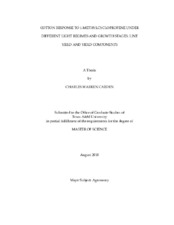| dc.description.abstract | Low photosynthetic photon flux density (PPFD) during certain growth periods of cotton (Gossypium hirsutum L.) has been shown to impact yield, ethylene synthesis, and fiber quality. Previous research with shading has shown that lint yield can be significantly reduced in the latter stages of growth. This two-year field study was conducted at the Texas A&M AgriLife Research Farm in Burleson County, Texas, in 2008 and 2009. The study evaluated the impact of an 8-day period of shade (63 percent reduction of PPFD) on cotton yield parameters, fiber quality, and the impact of 1-methylcyclopropene (1-MCP), an ethylene inhibitor, to alter detrimental cotton responses when applied as a foliar spray under shaded and non-shaded conditions. Shade and 1-MCP were imposed at four developmental stages of growth: pinhead square (PHS), first flower (FF), peak flower (PF), and boll development (BD). Data pooled over both years indicated that there were no significant differences in yield for 1-MCP treatments; however, numerical differences existed. Shade applied during the BD stage of development showed significantly lower yield than the untreated control. These results showed a decline in seed cotton and ginned seed cotton by 522 and 207 kg ha-1, respectively. To further analyze further yield components, box-mapping was conducted during both years. However, this data failed to explain consistent patterns of the observed yield responses. Data was also collected to determine the amount of fibers per seed and seed weights. Cotton fiber data did not show consistent correlations with the numerical increases and significant decreases in yield. Electrolyte leakage and stomatal conductance data also were collected. Electrolyte leakage showed no statistical differences when compared to the untreated control. Stomatal conductance measurements showed no consistency for treatments during both years. | en |


